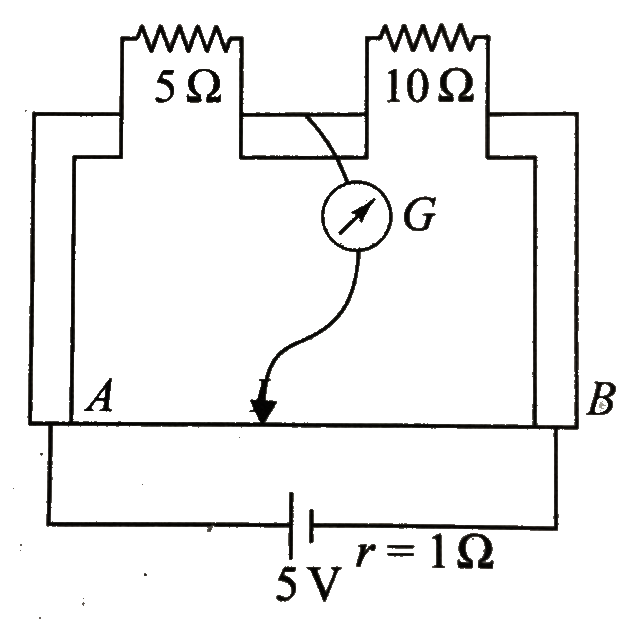Calculate the current flowing through a wire of resistance 7.5 Ω connected to a battery of potential difference 1.5. V.
To solve the problem of calculating the current flowing through a wire with a resistance of 7.5 ohms connected to a battery with a potential difference of 1.5 volts, we can follow these steps:
1. Identify the Given Values:
- Resistance (R) = 7.5 ohms
- Potential Difference (V) = 1.5 volts
2. Use Ohm's Law:
- Ohm's Law states that V=I×R, where:
- V is the potential difference,
- I is the current,
- R is the resistance.
- We need to find the current I.
3. Rearrange the Formula:
- To find the current I, rearrange the formula:
I=VR
4. Substitute the Values:
- Substitute the known values into the rearranged formula:
I=1.5volts7.5ohms
5. Calculate the Current:
- Perform the division:
I=1.57.5=0.2amperes
6. Conclusion:
- The current flowing through the wire is 0.2amperes.
Final Answer:
The current flowing through the wire is 0.2 amperes.
- Resistance (R) = 7.5 ohms
- Potential Difference (V) = 1.5 volts
- Ohm's Law states that V=I×R, where:
- V is the potential difference,
- I is the current,
- R is the resistance.
- We need to find the current I.
- To find the current I, rearrange the formula:
I=VR
- Substitute the known values into the rearranged formula:
I=1.5volts7.5ohms
- Perform the division:
I=1.57.5=0.2amperes
- The current flowing through the wire is 0.2amperes.
The current flowing through the wire is 0.2 amperes.
Topper's Solved these Questions
- BOOK - ICSECHAPTER - ELECTRICITY AND MAGNETISM EXERCISE - TOPIC 1 Electric Circuit (3 Marks Questions )9videos
ELECTRICITY AND MAGNETISM
- BOOK - ICSECHAPTER - ELECTRICITY AND MAGNETISM EXERCISE - TOPIC 1 Electric Circuit (4 Marks Questions )9videos
ELECTRICITY AND MAGNETISM
- BOOK - ICSECHAPTER - CURRENT ELECTRICITYEXERCISE - Exercise-9(C ) Multiple choice2videos
CURRENT ELECTRICITY
- BOOK - ICSECHAPTER - FLUIDSEXERCISE - TOPIC 2 (4 Marks Questions )16videos
FLUIDS
Similar Questions
Calculate the current flowing through a wire of resistance 5 Ω connected to a battery of potential difference 3 V.
View SolutionCalculate the current flows through resistance 2Ω.
 View Solution
View SolutionA current 0.2A flows in a wire of resistance 15Ω. Find the potential difference across the ends of the wire.
View SolutionCalculate the amount of charge flowing in 2 minutes in a wire of resistance 10Ω when a potential difference of 20 V is applied between its ends
View SolutionA potentiometer wire of length 10m and resistance 30Ω is connected in series with a battery of emf 2.5V, internal resistance 5Ω and an external resistance R. If the fall of potential along the potentiometer wire is 50μVmm−1, then the value of R is found to be 23nΩ. What is n?
View SolutionIn a meter bridge circuit, the two resistances in the gap are 5Ω and 10Ω. The wire resistance is 4Ω. The emf of the cell connected at the ends of the wire is 5V and its internal resistance is 1Ω. What current will flow through the galvenometer of resistance 30Ω if the contact is made at the midpoint of wire ?
 View Solution
View SolutionA potentiometer circuit is shown in Figure 3. AB is a uniform metallic wire having length of 2 m and resistance of 8Ω. The batteries E1andE2 have emfs of 4V and 1.5 V and their internal resistance are 1Ω and 2Ω respectively.

When the jockey J does not touch the wire AB, calculate :
(a) the current flowing through the potentiometer wire AB.
(b) the potential gradient across the wire AB.View SolutionAn ideal battery of emf 2 V and a series resistance R are connected in the primary circuit of a potentiometer of length 1 m and resistance 5Ω The value of R, to give a potential difference of 5 m V across 10 cm of potentiometer wire is
View SolutionA coil of self inductance 2.5 H and resistance 20Ω is connected to a battery of emf 120 V having internal resistance of 5Ω. Find :
The current in the circuit in steady state.View Solution(a) A current of 1A flows in a series curcuit containing an electric lamp and a conductor of 5Ω when connected to a 10V battery. Calculate the resistance of the electric lamp.
(b) Now if a resistance of 10Ω is connected in parallel with this series combination, what change (if any) in current flowing through 5Ω conductor and potential difference across the lamp will take place ? Give reason.View Solution

